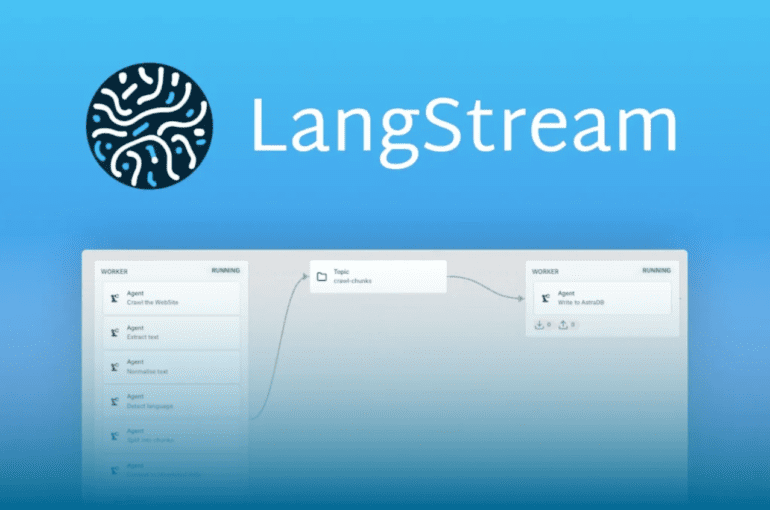TL;DR:
- DataStax introduces LangStream, a new open-source project.
- LangStream combines data streaming and generative AI for AI app development.
- The platform emphasizes event-driven and streaming architectures.
- It supports vector databases like Astra DB, Milvus, and Pinecone.
- LangStream automates data vectorization and real-time data evaluation.
- Developers can use a “no-code” approach or write custom agents in Python.
- LangStream complements LangChain, enabling the app transition to event-driven architecture.
- It offers a more secure backend-to-frontend architecture compared to JavaScript frameworks.
- LangStream enables innovative chatbot experiences, initiating conversations.
Main AI News:
DataStax, a long-standing player in the cloud-native community, has unveiled a groundbreaking open-source initiative named LangStream. This innovative project marries the worlds of data streaming and generative AI, setting the stage for a new era in AI app development. In our exclusive interview with Chris Bartholomew, a seasoned streaming engineer and the project’s lead, we delve into the significance of LangStream in the burgeoning AI app ecosystem and explore its potential parallels with the widely acclaimed LangChain project.
DataStax’s Evolution
DataStax, with a legacy spanning over a decade, initially gained recognition in the cloud-native landscape for its data management product built on the open-source NoSQL database, Apache Cassandra. In recent years, the company has rebranded itself as “the real-time AI company,” signaling a strategic shift towards generative AI solutions.
Unlocking LangStream’s Potential
At its core, LangStream is hailed as a platform tailored for crafting and deploying event-driven generative AI applications. What distinguishes it from existing AI app development frameworks is its emphasis on event-driven and streaming architectures. These architectures prove particularly advantageous for generative AI applications, boasting the capability to handle vast data volumes and prioritize the most recent and pertinent information.
As Bartholomew aptly puts it, “The newer and more relevant your data, the better when you’re building your prompts and sending them to the LLM.”
LangStream and Vector Databases
LangStream adopts an agnostic and vendor-neutral stance, providing support out of the box for DataStax’s vector database, Astra DB. Moreover, it extends compatibility to other prominent open-source vector databases, including Milvus and Pinecone.
Integrating LangStream with a vector database involves a two-step workflow. Firstly, unstructured data undergoes vectorization, orchestrated by specialized agents that crawl websites or retrieve documents from sources like S3 buckets. These agents then segment and apply embedding models sourced from platforms such as OpenAI or Hugging Face, resulting in data that seamlessly integrates with a vector database.
The subsequent phase hinges on leveraging this data within an application, such as a generative AI chatbot. When a user query is received, LangStream employs the RAG pattern (Retrieval Augmented Generation) to probe the database for pertinent information, transforming it into a prompt for a Language Model (LLM) and invoking the model.
Real-Time Data Dynamics
Bartholomew underscores the dynamic nature of data, especially in vector format, emphasizing its continual evolution and non-static attributes. This dynamism necessitates regular reevaluation of data employed in LLM applications.
LangStream ingeniously addresses this challenge by implementing an automatic pipeline that perpetually evaluates incoming data for freshness and relevance.
Building Apps with LangStream
Incorporating LangStream into LLM application development follows a flexible approach. For novice users, LangStream offers a “no-code” interface, enabling them to construct pipelines by configuring and combining various “agents.” Advanced developers, on the other hand, can harness the power of Python to craft custom agents.
Bartholomew elaborates, “You can write any kind of bespoke code you want. We also pre-install popular Python libraries, like LangChain and LlamaIndex, into the runtime environment.”
This runtime environment, underpinned by Kubernetes and Apache Kafka, ensures reliability, elevating LangStream beyond mere development into a dependable runtime for diverse applications.
LangStream and LangChain
Addressing the relation between LangStream and the well-known “Lang” product, Bartholomew emphasizes that LangStream complements LangChain. He draws an insightful parallel, stating, “You can take a prototype app created using LangChain and seamlessly run it within LangStream because, as I mentioned, LangStream serves as a runtime environment, not just a development environment.”
He further highlights the potential for “decomposing” or “recomposing” a LangChain app into an event-driven architecture, thereby transforming it into a distributed microservices-based application. This transition brings scalability and robustness to the forefront.
LangStream vs. the JavaScript Approach
In a landscape where JavaScript frameworks, like Next.js on Vercel’s platform, dominate AI application development, we question how LangStream diverges from this trend.
Bartholomew advises caution when interfacing directly with LLM systems via a browser frontend, as it may expose private keys. The LangStream approach champions security by advocating a backend-to-frontend architecture.
He elucidates, “You’ll have some authentication, that’s the method there, but you’re not exposing your keys to expensive LLM calls.”
DataStax’s LangStream leverages WebSocket gateways to facilitate seamless communication between the frontend and backend, showcasing a more secure and scalable architecture.
One standout application of this event-driven approach is what Bartholomew terms “a chatty chatbot.” Unlike conventional chatbots that solely respond to queries, this innovative chatbot can initiate conversations and keep them engaged. It represents a paradigm shift where chatbots proactively engage users, enhancing user interaction and experience.
Conclusion:
LangStream represents a significant leap forward in AI app development, capitalizing on real-time data integration and event-driven architecture. Its flexibility, compatibility, and security-conscious approach position it as a game-changer in the market, catering to both novice and experienced developers. With LangStream, DataStax solidifies its role as an innovator, driving the future of AI application development.

